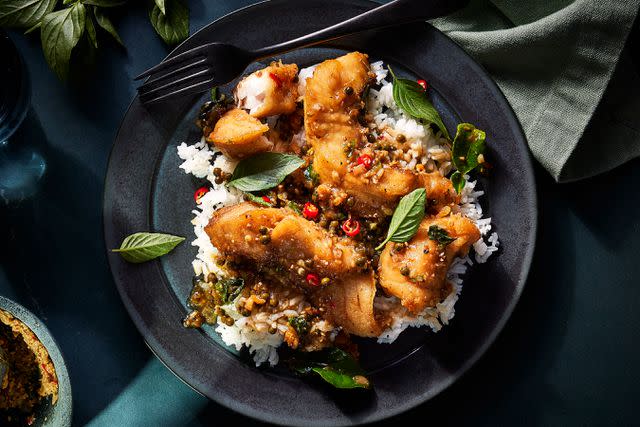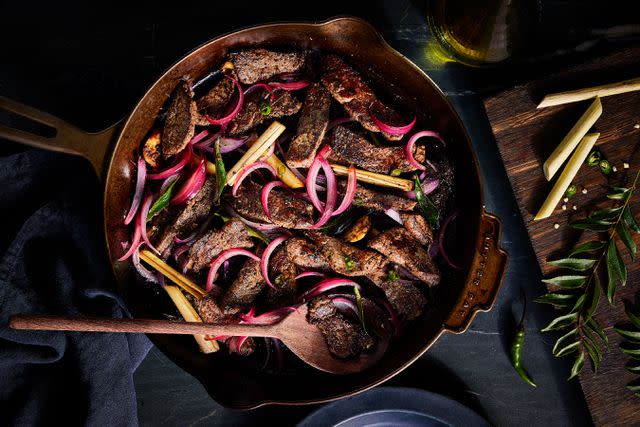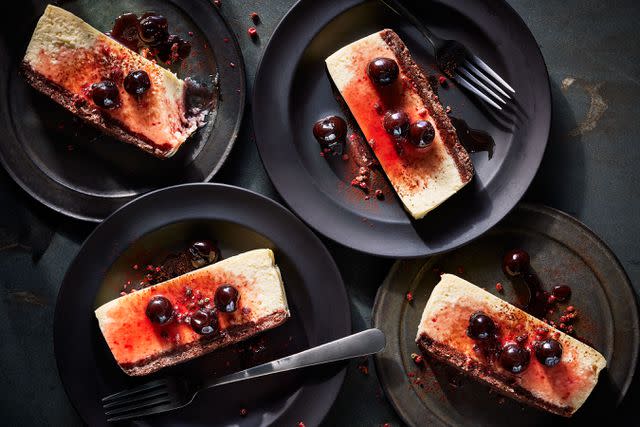Where Does Black Pepper Come From? A Guide to Peppercorns and How to Use Them
Black pepper is the dried berry of a flowering vine called Piper nigrum, which is dried to make black peppercorns.

Jennifer Causey / Food Styling by Chelsea Zimmer / Prop Styling by Christine Keely
We are living in the golden age of pepper.
The humble black peppercorns in the grinder next to the salt, the same ones you might crush over your Caesar salad, use to encrust a steak, toast for cacio e pepe, or sprinkle on scrambled eggs, have never been better in quality — or more available to home cooks around the world — as in our current era.
This was not always so. Pepper was once expensive, rare, and incredibly in-demand, so highly prized that in 410 A.D., Visigoths demanded 3,000 pounds of black pepper as part of their ransom for the city of Rome, which fascinated whole civilizations across Europe and Asia. Pepper powered the economies of entire nations. It was one of the driving forces of a spice trade that led to the oppressive system of European colonialism and its lingering historical consequences for huge swaths of humanity.
Today, black pepper remains the most popular spice on the planet, accounting for such a large part of the global spice trade that you can track its price as a commodity alongside wheat, corn, and rice. According to market research company IMARC, in 2021, the black pepper market was valued at $3.9 billion, with projections that it will grow to $5.4 billion by 2027. And yet, now that pepper is never that far away from our fingertips, it is too often underappreciated.
Where does black pepper come from?
Black pepper is the dried berry of a flowering vine called Piper nigrum, which fruits in clusters like grapes. Technically, peppercorns are drupes, or stone fruits, like cherries and peaches. To make black pepper, farmers harvest the still-green unripe peppercorns and dry them either by machine or in the sun, which causes the thin fruit layer to darken and wither, raisin-like, around the seed, resulting in the characteristic dark, puckered peppercorns you load into your pepper grinder.

Jennifer Causey / Food Styling by Chelsea Zimmer / Prop Styling by Christine Keely
Between the farmers who picked the peppercorns and your dining room table, there are many middlemen, processors, and wheeler-dealers obfuscating the origin and treatment of black pepper. It’s a supply chain with a great deal of intentional opacity, and the boom in high-quality pepper today is due in large part to efforts over the past couple of decades to make that system more transparent.
Because pepper is globally traded, a booming crop in, say, Vietnam means that a farmer in Brazil would get a lower price for their crop. Their only recourse would be to then sit on the peppercorns until prices go up to sell them, meaning that by the time peppercorns reach the grocery store shelves, they could be several years old. “If you go back to a few years ago, pepper was being very poorly cared for post-harvest, and the effect of that was [that] everything was [focused on] reconditioning instead of preserving the original quality,” says Mark Barnett, former owner of spice company Pacific Basin Partnership Inc.
When Barnett first began exporting spices from Vietnam in 1994, just after the U.S. lifted its trade embargo with the system, he saw farmers drying peppercorns in the middle of the road, often in proximity to horses and dogs. In partnership with the farmers, he worked to shorten supply routes and change drying and sterilization processes so that there was a more consistent, higher-quality crop exported. In the past few decades, the general quality of pepper has improved exponentially as similar methods have become more widespread.
The Rise of Single-Origin Pepper
Also in the past decade, a crop of spice companies including Burlap & Barrel, Mala Market, Diaspora Co., and Frontier Co-Op have been working to make the spice trade system still more equitable and transparent, resulting in better wages for farmers and a fresher end product for pepper enthusiasts. In a culinary world where people concentrate on local produce and sustainably sourced seafood, a new chorus of voices hopes to bring that same understanding to spices and in particular to peppercorns — the ingredient that Sana Javeri Kadri, founder and CEO of spice company Diaspora Co., calls “the gateway to spices.” (For the best sustainably sourced pepper for your kitchen, see “Guide to Pepper,” below.)
The fact that commodity pepper goes through many hands means that there’s plenty of opportunity for unscrupulous spice traders to adulterate pepper or trade off cheaper, lower-quality peppercorns for export. “When we export the pepper, we have to disclose the price that we pay for it to the export-import authority, and they give us hell,” says Kadri, who sources Diaspora Co.’s Aranya Black Pepper from Kerala, India. “They’re like, ‘Why are your customers in America paying so much for this? Do you want to just sell them some commodity pepper and continue to get the same price?’ It’s just too tempting for them to want to include some kind of scam because so many exporters are shortcutting and coming up with other ways to pull this stuff off.”
They are new supply chains that need to be built, painstakingly, from scratch because the past systems were so rife with injustice. Kadri compares it to the reframing of coffee in the past 30 years. “Coffee was always just a commodity, and what has happened in the past 20 years with the specialty coffee industry is it created a whole new world,” Kadri says. “I think that’s what needs to happen in the world of spices.” The increase in supply chain equality isn’t just good for pepper producers and workers, but for anyone who loves pepper.

Jennifer Causey / Food Styling by Chelsea Zimmer / Prop Styling by Christine Keely
Guide to Pepper
The golden age of pepper also means that cooking with peppercorns right now is just plain exciting. There’s a reason that pepper is the king of spices — it offers a way into a vast number of cuisines. There is a huge world within those tiny peppercorns, and all you need to access it is a grinder. There are many different varieties of pepper, and even more ways to cook with them.
Black pepper
The mature berries of a flowering vine are dried to create black pepper. Within black pepper, there are many flavor nuances. “A number of factors determine a peppercorn’s flavor, including the terroir, where and how it’s grown, and when it’s harvested in the ripening cycle,” explains Ethan Frisch, cofounder of spice company Burlap & Barrel. If peppercorns are allowed to ripen on the vine rather than being harvested while green, for example, the peppercorns have a mellower, fruitier, balsamic-like flavor. Frisch describes pepper from Zanzibar as “super lemony,” while other peppercorns might pick up notes of chocolate, coffee, or herbs. (We especially love the Aranya Black Pepper from Diaspora Co., which has rich notes of nutmeg and fig.)
Green pepper
Green peppercorns are the same berries as black pepper, but freeze-dried, brined, or used fresh. These dried, immature pepper berries have a bright, herbaceous flavor. Fresh green peppercorns, available sometimes at Thai supermarkets or sold as brined online, give tiny pops of heat and freshness to dishes, like spicy capers. If brined instead of dried, they make a salty, zesty, caper-like ingredient.
White pepper
White peppercorns are the seeds of the berries that have been denuded of the fruit layer. In French cooking, white pepper is typically used for aesthetic purposes, to prevent black dots from coloring lighter-hued dishes. In some Southeast Asian countries, white pepper is made by leaving the peppercorns in water to remove the fruit, fermenting the pepper, which gives it a pleasing, cheese-like funkiness. (We especially recommend Burlap & Barrel’s Fermented White Peppercorns. Sourced from a farm in Indonesia, they have a funky, umami flavor.)
Pink pepper
Pink peppercorns have nothing to do with Piper nigrum but come from one of three plants: Schinus molle, native to Peru; Schinus terebinthifolius, the Brazilian pepper tree; or Euonymus phellomanus, aka the baies rose plant, from Madagascar. The more mellow profile of pink peppercorns lends itself well to sweet applications like ice cream, and desserts like our Pink Peppercorn Cheesecake. (We recommend the fruity, delicate pink peppercorns from Spice Walla).
Szechuan and Sansho pepper
Szechuan and sansho pepper are the dried fruits of two kinds of trees in the prickly ash family. They both deliver a pungent, citrusy flavor and give a buzzing, tingling sensation to the mouth. Sansho peppercorns from Japan are green and have a more lemony flavor. Chinese Szechuan peppercorns are often toasted, giving them a woodsiness and a beautiful red-pink color. Their signature numbing and tingly properties, are perfect to riff on traditional Szechuan dishes like mapo tofu or even to grind on top of popcorn. Fermented white peppercorns offer a deeply umami, cheese-like tang to Indonesian dishes like nasi goreng and Perkedel Kentang, as well as to vegan cacio e pepe. (Order high-quality Szechuan peppercorns from The Mala Market.)
Recipes
Pla Phadcha (Thai Fried Fish with Spicy Chile Sauce)

Jennifer Causey / Food Styling by Chelsea Zimmer / Prop Styling by Christine Keely
Lightly crisp, tender fish gets a sweet tang from oyster sauce and mild, fresh piquancy from fingerroot, a rhizome similar to young ginger. Brined green peppercorns lend a burst of juicy, tart, and salty flavor. Be gentle with the fish when frying to keep slices intact.
Black Pepper Beef

Jennifer Causey / Food Styling by Chelsea Zimmer / Prop Styling by Christine Keely
Thin slices of beef tenderloin are simply seasoned with salt and freshly ground black pepper before being quickly sautéed with piquant green Thai chiles, citrusy and floral lemongrass, sweet red onion, and ginger in this adaptation of Cynthia Shanmugalingam’s Black Pepper Beef from her Sri Lankan cookbook Rambutan. Bruising the lemongrass before cooking releases the aroma and flavor from their tough, woody stalks.
Mala Stir-Fried Paneer

Jennifer Causey / Food Styling by Chelsea Zimmer / Prop Styling by Christine Keely
Tender and mildly flavored, paneer is the perfect neutral canvas to showcase the intricacies of Jonathan Kung’s mala spice. His mix combines Szechuan er jing tiao chiles, Szechuan peppercorns, and sansho peppercorns for a tingling, numbing sensation that’s layered with smoky flavor and bright, citrusy notes. Szechuan er jing tiao chiles bring a mild heat to the mix. If you can’t find them, you can substitute any other Szechuan chile, but pay attention to the heat level.
Perkedel Kentang (Indonesian Potato Fritters)

Jennifer Causey / Food Styling by Chelsea Zimmer / Prop Styling by Christine Keely
These golden, white pepper–spiced potato fritters are Indonesia’s take on the Dutch frikandel, a pan-fried meat- ball. In this version, the potatoes are spiked with the earthy, sharp heat of white pepper and the sweet and aromatic crunch of fried shallots. A beaten-egg batter encases the fluffy, pillowy mash and keeps the perkedel’s exterior light and crispy.
Pink Peppercorn Cheesecake

Jennifer Causey / Food Styling by Chelsea Zimmer / Prop Styling by Christine Keely
When pastry chef Natasha Pickowicz is looking to enhance a dessert with soft piquancy, she turns to the pink peppercorn. Freshly ground, the berries lift and brighten sweet treats, such as this silky steakhouse-style cheesecake, without overpowering the other flavors. Infusing the custard with freshly ground pink peppercorn adds a delicate fruitiness that balances out its creamy richness.
For more Food & Wine news, make sure to sign up for our newsletter!
Read the original article on Food & Wine.

